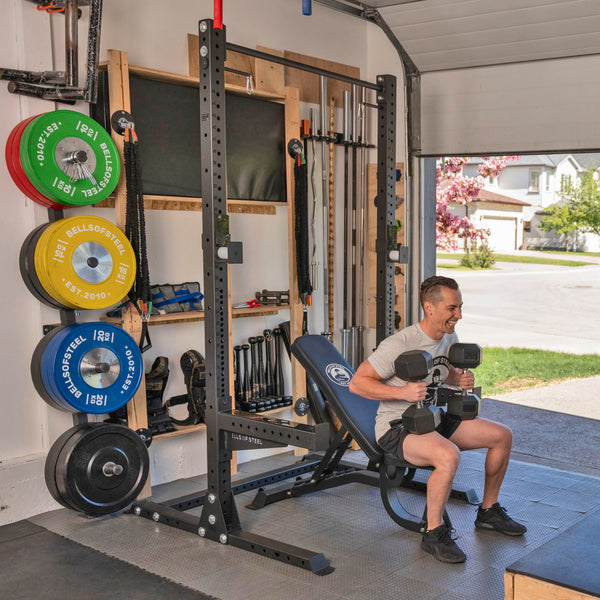Alright, home gym heroes, let’s tackle the age-old debate: Is a cable crossover the same as flyes? If you’ve ever pondered this while flexing in the mirror, you’re in the right place. We’re diving deep into these two chest-pumping exercises to highlight their similarities, differences, and everything in between. Let’s get those pecs popping!
What Are Flyes?
Flyes are a classic chest exercise that you'll often see gym-goers performing with dumbbells on a bench. Imagine you're a majestic bird flapping its wings, except you're lying down and lifting weights. The primary goal here is to isolate the pectoral muscles and give them a good stretch and squeeze.
What Are Cable Crossovers?
Cable crossovers, on the other hand, are performed on a cable machine. You stand between two high pulleys, grab the handles, and bring them together in front of you, like you're about to give a bear a big ol' hug. This exercise is fantastic for working the chest through a full range of motion while keeping constant tension on the muscles.
Similarities Between Flyes and Cable Crossovers
Both flyes and cable crossovers are designed to target the pectoral muscles. They focus on the stretching and contracting motion that really hits the chest hard. Whether you’re using dumbbells or cables, you’ll be mimicking a hugging motion that’s all about chest activation.
Differences Between Flyes and Cable Crossovers
Equipment
Flyes typically require a bench and a set of dumbbells. They’re straightforward and perfect for home gyms with limited equipment. Cable crossovers, however, need a cable machine, which can take up a bit more space and investment.
Range of Motion and Tension
Flyes can sometimes feel limited in range of motion, especially if your flexibility isn't great or if your dumbbells hit the ground. Cable crossovers, however, allow for a greater range of motion and provide constant tension throughout the movement, thanks to the cable resistance.
Stability and Muscle Engagement
Flyes engage stabilizer muscles because you’re balancing free weights. This can be beneficial for overall muscle development but also makes the exercise a bit more challenging to master. Cable crossovers, with their guided path, allow you to focus more on the chest contraction and less on stabilizing the weights.
Pros and Cons of Flyes
Pros
- Simplicity: Easy to set up with just a bench and dumbbells.
- Stabilizer Muscle Engagement: Helps improve balance and coordination.
- Cost-Effective: No need for expensive equipment.
Cons
- Range of Motion: Can be limited by flexibility and bench position.
- Risk of Injury: More strain on the shoulder joints if not done with proper form.
- Constant Tension: Lacks the continuous resistance that cables provide.
Pros and Cons of Cable Crossovers
Pros
- Constant Tension: Keeps your muscles under tension throughout the movement.
- Range of Motion: Allows for a more extended range, hitting the chest from different angles.
- Variety: Multiple adjustments and variations to target different parts of the chest.
Cons
- Equipment Needed: Requires a cable machine, which takes up more space and money.
- Learning Curve: Takes some time to master the form and technique.
FAQs About Flyes and Cable Crossovers
Can I build a big chest with just flyes or cable crossovers?
Both exercises are great for chest development, but for a well-rounded chest workout, it’s best to include a variety of exercises like bench presses, push-ups, and dips.
How many sets and reps should I do?
Aim for 3-4 sets of 10-15 reps for both exercises. Focus on quality reps with a good stretch and squeeze at the top.
Which is better for beginners?
Flyes are generally easier to start with due to the minimal equipment required. However, beginners can also benefit from cable crossovers if they have access to a cable machine and can learn the proper form.
Can I do these exercises at home?
Absolutely! If you have a bench and dumbbells, you’re set for flyes. For cable crossovers, investing in a cable machine like the ones from Bells of Steel can make your home gym even more versatile.
Conclusion: Fly High or Cable Tight?
So, are cable crossovers the same as flyes? Not quite, but they’re both fantastic exercises for targeting your chest. Flyes offer simplicity and stabilizer muscle engagement, while cable crossovers provide continuous tension and a greater range of motion. Both should have a place in your workout routine for a balanced, effective chest workout.
Whether you’re flapping like a majestic bird or hugging an imaginary bear, your pecs will thank you. Keep mixing it up, and remember, consistency is key to building that chest of steel!



